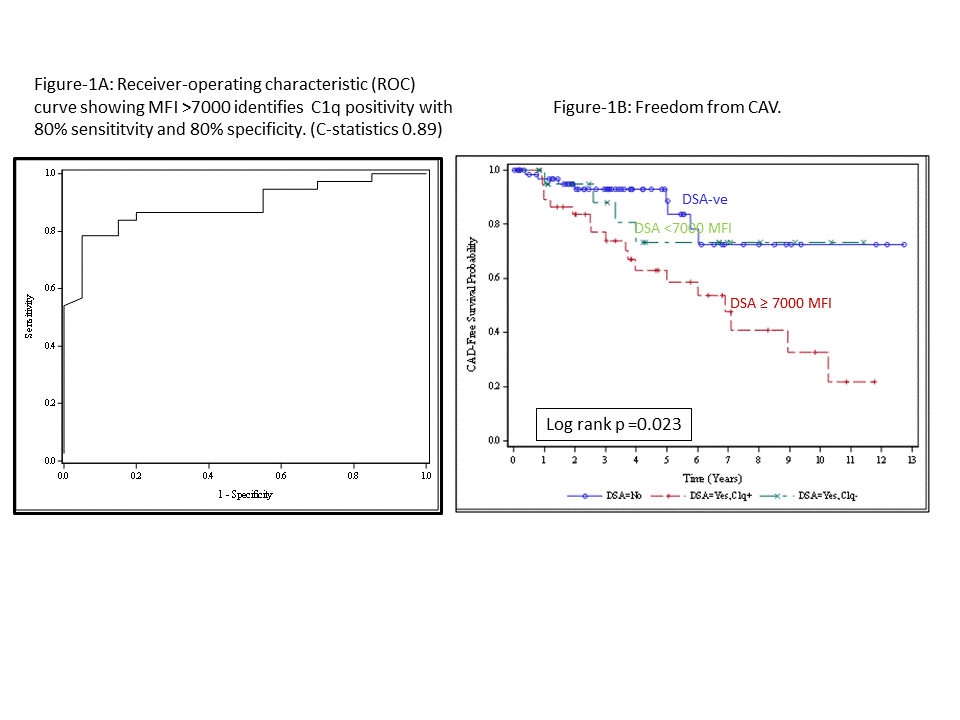High Titer De Novo Donor-Specific HLA Alloantibodies and Cardiac Allograft Vasculopathy After Pediatric Heart Transplantation.
1Division of Cardiology, Dept. of Pediatrics, UTSW Medical Center, Dallas, TX
2Department of Clinical Science Research, UTSW Medical Center, Dallas, TX
3Department of Pathology, UTSW Medical Center, Dallas, TX
Meeting: 2017 American Transplant Congress
Abstract number: 223
Keywords: Alloantibodies, Graft arterlosclerosis, Heart transplant patients
Session Information
Session Name: Concurrent Session: Heart Transplantation: Antibodies and Outcomes
Session Type: Concurrent Session
Date: Monday, May 1, 2017
Session Time: 2:30pm-4:00pm
 Presentation Time: 3:18pm-3:30pm
Presentation Time: 3:18pm-3:30pm
Location: E271b
Background: Cardiac allograft vasculopathy (CAV) continues to be a limiting factor in long-term survival after pediatric heart transplantation (HT). Criteria for early diagnosis of CAV remains elusive.
Aim: We hypothesized that high titer de novo donor specific antibodies (DSA) detected after HT confers the greatest risk for CAV. This study aimed to investigate the relationship of CAV with de novo DSA ≥ 7000 MFI in pediatric HT recipients.
Method: 127 patients transplanted from 2005 to 2014 were analyzed in this retrospective study to evaluate the incidence of CAV in pediatric HT recipients who had DSA≥ 7000 MFI compared to those with DSA < 7000 MFI. The cut-off value of DSA 7000 MFI was determined based on ability of DSA binding to complement as determined by C1q testing (C1qScreenTM and LAB Screen Single Antigen, One Lambda).
Results: Out of 127 patients, 59 (46.4%) patients developed de novo DSA. Of patients with positive DSA, 4(6.7%)patients had class I DSA (mean MFI 2,653 with 25th to 75th percentile: 1,223-4,296), 27(45.7%) patients had class II DSA (mean MFI 10,784 with 25th to 75th percentile: 4,291-15,869) and 28(47.6%) patients had both Class I and Class II DSA (mean MFI 10,521 with 25th to 75th percentile: 4,279-16,200). Among class II HLA antibodies, DQ was most prevalent in our cohort. The receiver-operating characteristic curve showed that a DSA at ≥ 7000 MFI identified as C1q positive (C= 0.89). When we analyzed the incidence of CAV in patients who had DSA ≥7000 MFI, freedom from CAV in patients with DSA ≥7000 MFI was 96%, 60% and 36% at 1, 5 and 10 years compared with 98%, 70% and 62% in patients with DSA <7000 MFI (log-rank P = 0.023).  Conclusion: Our results demonstrate that DSA ≥ 7000 MFI are likely to be complement fixing and are strongly associated with development of CAV in pediatric HT recipients. These findings, if substantiated in a larger cohort of cases, may help to better stratify patients into prognostic groups.
Conclusion: Our results demonstrate that DSA ≥ 7000 MFI are likely to be complement fixing and are strongly associated with development of CAV in pediatric HT recipients. These findings, if substantiated in a larger cohort of cases, may help to better stratify patients into prognostic groups.
CITATION INFORMATION: Das B, Zhang S, Gao A, Lacelle C. High Titer De Novo Donor-Specific HLA Alloantibodies and Cardiac Allograft Vasculopathy After Pediatric Heart Transplantation. Am J Transplant. 2017;17 (suppl 3).
To cite this abstract in AMA style:
Das B, Zhang S, Gao A, Lacelle C. High Titer De Novo Donor-Specific HLA Alloantibodies and Cardiac Allograft Vasculopathy After Pediatric Heart Transplantation. [abstract]. Am J Transplant. 2017; 17 (suppl 3). https://atcmeetingabstracts.com/abstract/high-titer-de-novo-donor-specific-hla-alloantibodies-and-cardiac-allograft-vasculopathy-after-pediatric-heart-transplantation/. Accessed December 17, 2025.« Back to 2017 American Transplant Congress
